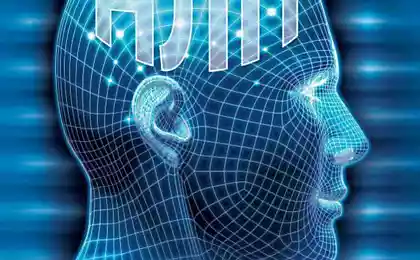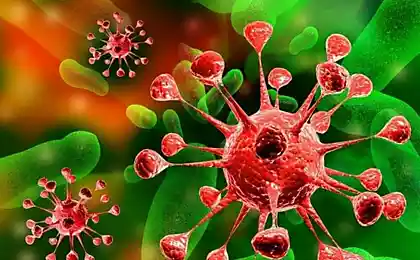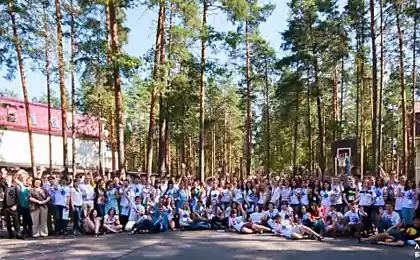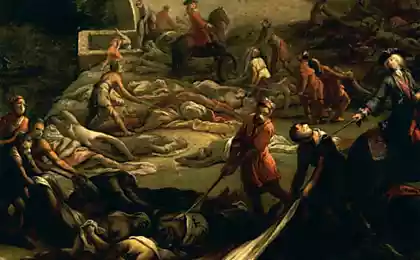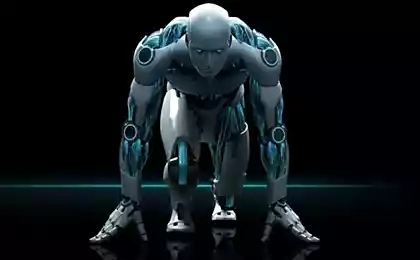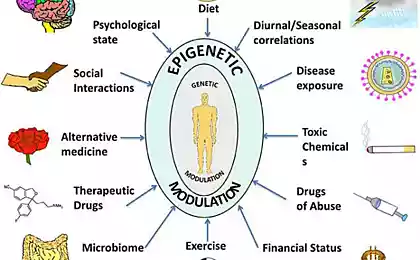557
Viruses — part of the human genome. Unfortunately, it is so
The invisible fight between man and these "intracellular parasites", like viruses, occurred for millennia. Only after detecting D. I. Ivanovski in 1892 humanity finally recognized his invisible enemy, which, penetrating the human cell uses all of its features for their own selfish purposes, thereby affecting the normal cell metabolism and causes different severe diseases.
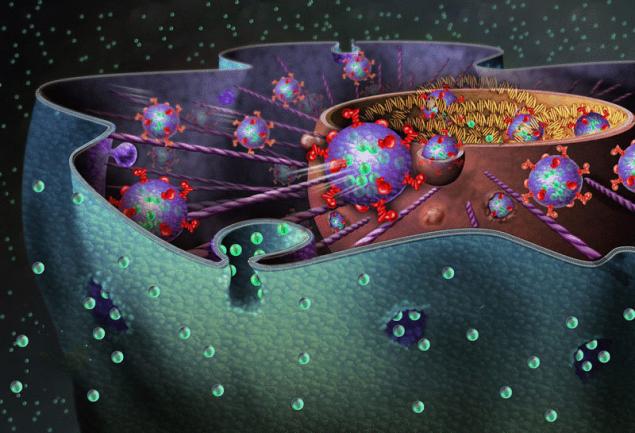
The number of viruses has the ability to penetrate into the human genome, and in fact to become like his own genes. This primarily refers to the so-called retroviruses. They were so named for their way of life. The original genome of these viruses is an RNA. But, once in the cell, the virus in its RNA using reverse transcriptase builds a DNA copy (see the main dogma of molecular biology). After this DNA copy of the virus integrates into the genome of cells, which is essential for the life cycle of the retrovirus. Embedded in the genome of human cells a DNA copy of the virus was called provironum. Then provirus synthesized viral RNA, on the basis of which the formation of new viral particles. Is the life cycle of a typical retrovirus. So behave, for example, a well-known retrovirus called the human immunodeficiency virus (HIV), when it infects red blood cells.
It seemed that all of this is a problem of individual infected cells. Indeed, the viruses mainly infect somatic cells. Then the viruses and proviruses die with those cells in which they managed for a while. Ie, the viruses themselves and prepare their own death. However, this does not always occur. Very rarely in human evolution occurred infection with viruses cells of embryonic path formed provirus, but the body survived and embedded provirus became inheritable element of the human genome. So the cell appears "reprogramme" (provirus), which alters the genome is much stronger than is possible with a "normal" evolutionary variation.
When sequenced the genome of humans and many other mammals, it was found that in their composition contains a very large number of repeated elements having similarity with infectious viruses. Repetitive elements are able to encode 2-3 protein and is surrounded on two sides another special replays — called long terminal repeats (DCT) was related to the family, called retrotransposons. In humans they make up quite a substantial portion — about 8 % of the genome. Such elements are often referred to as endogenous retroviruses, in contrast to typical retroviruses that exist in nature outside of organisms (they are called exogenous retroviruses.
Still, for millions of years ancient proviruses it was difficult to remain unchanged. Most of these elements represents defective viral sequences or even individual short fragments.
Mutations accumulated in the course of evolution in endogenous retroviruses, do not allow them to form new infectious viral particles, as is usual in the case of typical exogenous viruses (e.g., virus immunodeficita the person calling is a terrible disease, like AIDS).
It is estimated that such provirus appeared in the human genome from 10 to 50 million years ago as a result of infection of the germ cells of our predecessors since inherited as all other proprietary elements of the genome. So "foreign" DNA molecules become part of our genome. In sum, there are tens of thousands, they consist of more than 200 different groups and subgroups. The retrotransposons of the human genome is often seen as "fossils" of ancient retroviruses.
Thus, endogenous proviruses are "traces" of viruses that infected our ancestors millions of years ago. Settled in the genome of our ancestors, they eventually lost the ability to form new viral particles. Most of these "relict" retroviruses "silent" (not functioning). Now, however, it has been established that under certain influences on the genome they can "speak" and thereby disrupting the normal metabolism in the cell. Thus, potentially some of them and after thousands of years continue to pose a potential danger to humans.
It turned out that some members of the family of retroviruses have retained the ability to synthesize RNA, and also have a penchant for recombination and transfer in the genome. Thus, the analysis of endogenous proviruses of the human genome allows us to conclude that some of them are copies of the resulting so-called retroposition. Retroposition is the process of emergence of new copies in the genome not due to new infection with the virus, and in the process of transcription existing in the genome of provirus.
In the human genome are endogenous retroviruses are found in many places, but their distribution on the chromosomes is not completely uniform. There are areas enriched by them, and at the same time some areas of the human chromosomes do not contain such elements. Some say that the location of endogenous retroviruses and their derivatives correlates with the distribution of genes in the genome. Often they are located in regulatory regions of genes. And at the same time, scientists see a special meaning: regulatory elements endogenous retroviruses can interfere in the regulation of normal human genes.
Viruses change our DNA.
It was found in recent studies of American scientists, a significant part of the diseases, which are detected in neonates, transmitted to them by heredity.
The examiners conducted observations of the children immediately after birth have been identified virus HHV-6, which is the causative agent of children's roseola (rubella). It turned out that the disease agent incorporated into the DNA structure of these children. In addition, studies have been conducted of the chromosomes of the parents of these children and they also had identified an identical formation. Thus, biologists concluded that the identification of a new method of transmission of the pathogen by genetic means at the moment of conception.
According to one of the authors of the study, the doctor of Medical centre of Rochester (NY) Carolyn bries the Hall, the results of the study raised a number of important issues. In particular, they have to establish how the information structure of the virus is integrated in human DNA, can they be activated again after people have had it and developed antibodies, as well as how effectively the human immune system to cope with the "genetic virus".
The authors of the study say that at the moment they have established the patterns of genetic transmission only elements of DNA roseola, but in the future it may be that other viruses also have this ability. In the absence of other pathogens such possibility, the problem is also significant, as the majority of children infected by the specified disease show the presence of its genome in the DNA, which leads to the occurrence of the disease in severe form, accompanied by high fever, rash and various side effects.
In the framework of the research, experts studied the samples taken from 250 newborns.85 of them suffered the disease roseola, and 43 of the children had discovered the genetic characteristics of infection, and 42 were infected after birth. The number of children with hereditary acquired disease exceeded 50 percent. 86 per cent of them originally had the chromosome of the virus in its genetic material.
Further analysis showed that at least one of the parents of infected children, in the DNA chain, also contains chromosome HHV-6.
Geneticists conclude that in some strange way, when you turn on the virus genome into the DNA of the person he chooses is the place of the chromosome which are responsible for the formation of the immune system. These places in the end of the chain are called telomerase. In case of damage immune response to the viruses is dulled.
As it became known from the world's media, in the medical field, another group of scientists working in the United States, were able to identify the composition of DNA and other types of viruses, such as Marburg virus and Ebola virus. Scientists claim that they exist in the human body for millions of years, but in the case of activation, may affect the nervous system and the brain, violating their work. The authors of the study do not offer methods of dealing with identified genomes, and still don't know whether you want to do to deal with them.published by P. S. And remember, just changing your mind — together we change the world! ©
Source: vk.com/probujdeniechelovechnost?w=wall-66683693_4480%2Fall

The number of viruses has the ability to penetrate into the human genome, and in fact to become like his own genes. This primarily refers to the so-called retroviruses. They were so named for their way of life. The original genome of these viruses is an RNA. But, once in the cell, the virus in its RNA using reverse transcriptase builds a DNA copy (see the main dogma of molecular biology). After this DNA copy of the virus integrates into the genome of cells, which is essential for the life cycle of the retrovirus. Embedded in the genome of human cells a DNA copy of the virus was called provironum. Then provirus synthesized viral RNA, on the basis of which the formation of new viral particles. Is the life cycle of a typical retrovirus. So behave, for example, a well-known retrovirus called the human immunodeficiency virus (HIV), when it infects red blood cells.
It seemed that all of this is a problem of individual infected cells. Indeed, the viruses mainly infect somatic cells. Then the viruses and proviruses die with those cells in which they managed for a while. Ie, the viruses themselves and prepare their own death. However, this does not always occur. Very rarely in human evolution occurred infection with viruses cells of embryonic path formed provirus, but the body survived and embedded provirus became inheritable element of the human genome. So the cell appears "reprogramme" (provirus), which alters the genome is much stronger than is possible with a "normal" evolutionary variation.
When sequenced the genome of humans and many other mammals, it was found that in their composition contains a very large number of repeated elements having similarity with infectious viruses. Repetitive elements are able to encode 2-3 protein and is surrounded on two sides another special replays — called long terminal repeats (DCT) was related to the family, called retrotransposons. In humans they make up quite a substantial portion — about 8 % of the genome. Such elements are often referred to as endogenous retroviruses, in contrast to typical retroviruses that exist in nature outside of organisms (they are called exogenous retroviruses.
Still, for millions of years ancient proviruses it was difficult to remain unchanged. Most of these elements represents defective viral sequences or even individual short fragments.
Mutations accumulated in the course of evolution in endogenous retroviruses, do not allow them to form new infectious viral particles, as is usual in the case of typical exogenous viruses (e.g., virus immunodeficita the person calling is a terrible disease, like AIDS).
It is estimated that such provirus appeared in the human genome from 10 to 50 million years ago as a result of infection of the germ cells of our predecessors since inherited as all other proprietary elements of the genome. So "foreign" DNA molecules become part of our genome. In sum, there are tens of thousands, they consist of more than 200 different groups and subgroups. The retrotransposons of the human genome is often seen as "fossils" of ancient retroviruses.
Thus, endogenous proviruses are "traces" of viruses that infected our ancestors millions of years ago. Settled in the genome of our ancestors, they eventually lost the ability to form new viral particles. Most of these "relict" retroviruses "silent" (not functioning). Now, however, it has been established that under certain influences on the genome they can "speak" and thereby disrupting the normal metabolism in the cell. Thus, potentially some of them and after thousands of years continue to pose a potential danger to humans.
It turned out that some members of the family of retroviruses have retained the ability to synthesize RNA, and also have a penchant for recombination and transfer in the genome. Thus, the analysis of endogenous proviruses of the human genome allows us to conclude that some of them are copies of the resulting so-called retroposition. Retroposition is the process of emergence of new copies in the genome not due to new infection with the virus, and in the process of transcription existing in the genome of provirus.
In the human genome are endogenous retroviruses are found in many places, but their distribution on the chromosomes is not completely uniform. There are areas enriched by them, and at the same time some areas of the human chromosomes do not contain such elements. Some say that the location of endogenous retroviruses and their derivatives correlates with the distribution of genes in the genome. Often they are located in regulatory regions of genes. And at the same time, scientists see a special meaning: regulatory elements endogenous retroviruses can interfere in the regulation of normal human genes.
Viruses change our DNA.
It was found in recent studies of American scientists, a significant part of the diseases, which are detected in neonates, transmitted to them by heredity.
The examiners conducted observations of the children immediately after birth have been identified virus HHV-6, which is the causative agent of children's roseola (rubella). It turned out that the disease agent incorporated into the DNA structure of these children. In addition, studies have been conducted of the chromosomes of the parents of these children and they also had identified an identical formation. Thus, biologists concluded that the identification of a new method of transmission of the pathogen by genetic means at the moment of conception.
According to one of the authors of the study, the doctor of Medical centre of Rochester (NY) Carolyn bries the Hall, the results of the study raised a number of important issues. In particular, they have to establish how the information structure of the virus is integrated in human DNA, can they be activated again after people have had it and developed antibodies, as well as how effectively the human immune system to cope with the "genetic virus".
The authors of the study say that at the moment they have established the patterns of genetic transmission only elements of DNA roseola, but in the future it may be that other viruses also have this ability. In the absence of other pathogens such possibility, the problem is also significant, as the majority of children infected by the specified disease show the presence of its genome in the DNA, which leads to the occurrence of the disease in severe form, accompanied by high fever, rash and various side effects.
In the framework of the research, experts studied the samples taken from 250 newborns.85 of them suffered the disease roseola, and 43 of the children had discovered the genetic characteristics of infection, and 42 were infected after birth. The number of children with hereditary acquired disease exceeded 50 percent. 86 per cent of them originally had the chromosome of the virus in its genetic material.
Further analysis showed that at least one of the parents of infected children, in the DNA chain, also contains chromosome HHV-6.
Geneticists conclude that in some strange way, when you turn on the virus genome into the DNA of the person he chooses is the place of the chromosome which are responsible for the formation of the immune system. These places in the end of the chain are called telomerase. In case of damage immune response to the viruses is dulled.
As it became known from the world's media, in the medical field, another group of scientists working in the United States, were able to identify the composition of DNA and other types of viruses, such as Marburg virus and Ebola virus. Scientists claim that they exist in the human body for millions of years, but in the case of activation, may affect the nervous system and the brain, violating their work. The authors of the study do not offer methods of dealing with identified genomes, and still don't know whether you want to do to deal with them.published by P. S. And remember, just changing your mind — together we change the world! ©
Source: vk.com/probujdeniechelovechnost?w=wall-66683693_4480%2Fall

